

![]()
![]()
All images were taken with a tripod mounted Canon G6 digicam under natural light conditions using overcast skies.
Please note, this is an extensive article, it may take some time to download for those with slow Internet connections.
I love old books and especially old microscopy books. My brother and I have been fortunate enough to acquire quite a few of the more commonly found microscopy books over a number of years dating between the late 19th and early 20th centuries some of which are still available through the Internet, for example through Savona Books UK or the Abebooks network, but be warned...some are now getting expensive. Many of the names given to the microscopic animals and plants studied by the Victorian microscopists have changed, but to me this is irrelevant since I particularly admire the way these early explorers of microscopy talked about their subjects, indeed, I commonly prefer the old names given at the time.
Read any modern tome on ecology of freshwater life today and more often than not you are bombarded with endless taxonomic terms which disjoints any means of actually reading about the subject; we seem to be reducing the pleasure of looking at things to a list of parts. In the never ending classification and re-classification are we losing touch with the wonder and fascination of looking at nature that surrounds us? In my first edition copy of John Clegg's excellent little book Freshwater life of the British Isles [the theme of which was later adapted into the Observer's Book of Pondlife] he says that some rotifers have had their names changed fifteen or twenty times with one referred to in different publications under forty seven different names and that was back in 1952! Reading old microscopy books can teach us a lot about writing with passion about the plants and animals that fascinate us and as amateurs we can keep that passion going through writing that is approachable to anybody showing an interest in the natural world. In mans' never ending quest to classify things we shouldn't lose sight of the marvels of nature. All these books are so old that copyright [...hopefully...] has expired, enabling me to share some of the wonderful pictures, drawings and writing skills used by these microscopists.
Text in black refers to my own thoughts on the readability and quality of the drawings whilst the blue italic text are passages and titles etc from the publications, so immerse yourself in a bygone era when these books were written, before motorways and highways, passenger jets and the stresses of modern life, to a time of the horse and carriage, steam trains and Sunday walks along the promenade; now let's see where's my 'time-machine' has gone, I left it somewhere...
I have included here a few pictures, sample drawings and text from the majority of the books that we have acquired, in some cases observations down the microscope in those days were written as self-contained beautiful little stories... roll on my first choice by H. J. Slack, this is definitely one of my all time favourite microscopy books, it has been read cover to cover several times and some passages many times. There are still quite a few copies around but be careful, prices vary considerably.
Marvels of Pond Life.
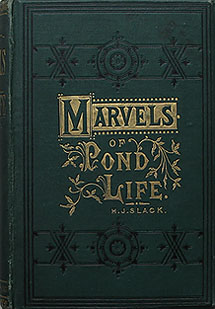
H. J. Slack. Marvels of Pond Life. Green cloth cover, this copy 1880.
At the time of publishing this copy Henry. J. Slack was President of the Royal Microscopical Society. The fact that he held such a prestigious position at the time and was still able to write in such a fluid and appealing manner to both microscopist and complete layman is a tribute to his writing skills. It is based in 1860 - A years observation down the microscope compiled into chapters covering the various months. I have read this twice just in the last few weeks and it can be read cover to cover in just one or two evenings. We are taken into an era where we can imagine the joy and fascination that looking down a microscope could bring and also his walks around the London area looking for likely ponds to sample. Even in 1871 he says that many of the ponds around about London had disappeared due to new construction. This style of writing has all but vanished now and it is a great shame. I think if I was a teacher at secondary school or university tutoring 'would be' microbiologists of the future the first enjoyable piece of homework would be to tell them to read this book. The fact that it was reprinted so many times gives you an idea of its popularity and along with many other books of the time it was meant to be carried about being a compact 7" high by 5" wide. The book was published by a couple of different publishers and can be found in several cover designs of various colours. I will now quote a few passages to give you an idea of its contents and I have used the original names of the subjects as given in the book.
From the Introduction.
The researches of recent philosophers have shown us that nature cannot be understood by studying the parts of animals with reference merely to their utility in the economy of the creature to which they belong. We do, indeed, find an admirable correspondence between structures and the services they perform; but every object in creation, and every part of it, is in harmonious relation to some grand design, and exhibits a conformity to some general mode of operation, or some general disposition and direction of forces, which secures the existence of the individual or the species, and at the same time works out the most majestic schemes.
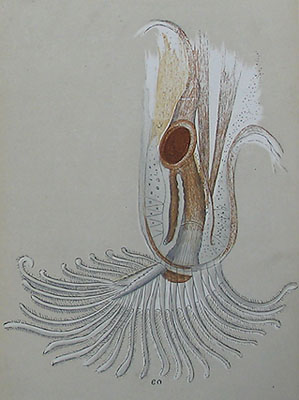
Plumatella repens. One of several colour prints in the book derived from drawings made by his wife of the actual objects seen with a few exceptions, where the authority is acknowledged.
From Chapter II. January.
Our mass of conferva [Algae] turns out to contain one of the most elegant species. Fine hair-like tubes of an organic material, as transparent as glass, are divided by partitions of the same substance into cylindrical cells, through which a slender ribbon of emerald green, spangled at intervals with small round expansions, is spirally wound. We shall call it the Spiral Conferva, its scientific name being Spirogyra quinina. Some other species, though less elegantly adorned, make a pleasing variety in the microscopic scene; and appended to some of the threads is a group of small crystal bells, which jerk up and down upon spirally twisted stalks. These are the "Bell Flower Animalcules" [Animalcules, small animals] of old observers, the Vorticella, or Little Vortex-makers of the present day. Other small creatures flit about with lively motions, and among them we observe a number of green spindles that continually change their shape, while an odd-looking thing crawls about, after the manner of certain caterpillars, by bringing his head and tail together, shoving himself on a step, and then repeating the process, and making another move. He has a kind of snout, behind which are two little red eyes, and something like a pig-tail sticks out behind. This is the Common Wheel-bearer, Rotifer vulgaris, a favourite object for microscopists, old and young, and capable, as we shall see, of doing something more interesting than taking the crawl we have described.
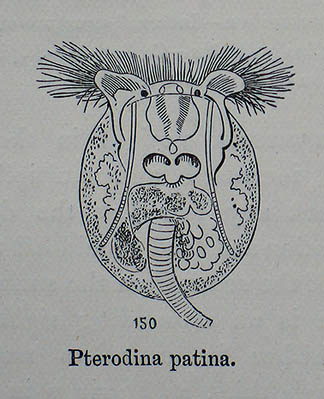
Close-up of one of the beautiful little drawings, and what a handsome 'Miss' Pterodina patina is!
From Chapter V. April.
The Beautiful Floscule [from the Latin Flosculus, a flower] could always be made to repeat the process of retreating into her den, and coming out again to spread her elegant plumes before our eyes, by giving the table a smart knock, and her colours and structure were well exhibited by the dark-ground illumination, which has been explained in a previous page...
...An object like this should be watched at intervals for hours and even days, especially if the eggs are nearly ready to give up their infantile contents. This was the case with the specimen described, and after a few hours a young Floscule escaped, looking very much like a clumsy little grub. After a few awkward wiggles the new-born baby became more quiet, and on looking at it again at the expiration of seventeen hours, it had developed into the shape of a miniature plum-pudding, with five or six tiny lobes expanding their tufts of slender hair. [This little paragraph always puts a smile on my face].
From Chapter VI. May.
The Melicerta [case building rotifer] is, however, an awkward object to undertake to show to our friends, for as they knock at the door she is apt to turn sulky, and when once in this mood it is impossible to say when her fair form will reappear. At times the head is wagged about in all directions with considerable vehemence, playing singular antics, and distorting her lobes so as to exhibit a Punch and Judy profile. When these creatures die they leave their tubes, which are often found empty in the ponds they frequent.
Hidden Beauties of Nature.
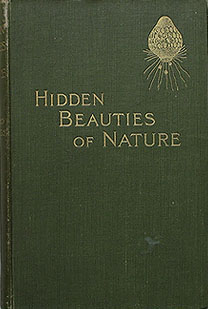
Hidden Beauties of Nature. Richard Kerr. F.G.S. Not dated but around the mid 1890s.
Another well written book, covered in a textured cloth it is in a writing style not dissimilar to H.J. Slack with very good drawings some of which are in white against a black background, it is slightly thicker than Mr. Slack's book at 224 pages compared to 147 and I include a couple of passages.
From the Introduction.
The tendency with a great number of people is to disregard Nature's wonders, and to select for their reading the light literature of the day, often very trashy and pernicious novels, instead. The gift of eyesight and the power to use the mind were intended for better studies.
Thousands of people pass through the span of life without ever having had the pleasure of seeing for themselves the surrounding loveliness of created things. How true, even in this respect, is the ancient saying, 'Eyes have they, but they see not'! The philosopher's words are as true today as when they were first uttered: 'A nations greatness depends upon the education of its people'. There is a great deal in that word 'education'.
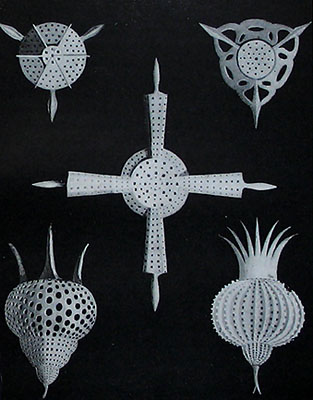
Fig 17. Polycistina of Barbados, Enlarged many hundred diameters.
From the Chapter Floscule and Volvox Globator.
Our microscopes are arranged, but a friend arrives who has never seen Volvox. To him the first view is conceded and all are curious to hear his opinion, though they can readily anticipate some of his exclamations, which are as follows:
'This is astronomy; these are not microscopic objects, for here are worlds revolving, some are gliding along most gracefully, while others are spinning on their axes-the light shows me they are translucently green, and that there are "other worlds" inside of these, and they are too rotating!'
The Microscope. Hogg.

The Microscope. Hogg. 15th Edition. 1898.
This is an altogether more substantial work running to over 690 pages in my 15th edition 1898 copy. Measuring [8 3/4" high by 6 1/2" wide, the same as the Micrographic Dictionary below] it is beautifully bound in red leather and it's still in remarkably good condition considering its age. A stamp inside says it came from Kings College Hospital medical school so it may have had quite a lot of handling. The book is a good introduction to the theory of light and the microscope, objectives and accessories and their use, with most of the techniques as relevant today as when they were written. Later chapters cover many of the subjects you can see through the microscope and the book is liberally accompanied with excellent line drawings like those below together with some colour prints which are still vibrant in colour. Strangely, although nicely bound the pages are very roughly cut giving the overall effect a somewhat 'ragged' appearance which spoils it. I suspect this varies with the edition and publishing date.
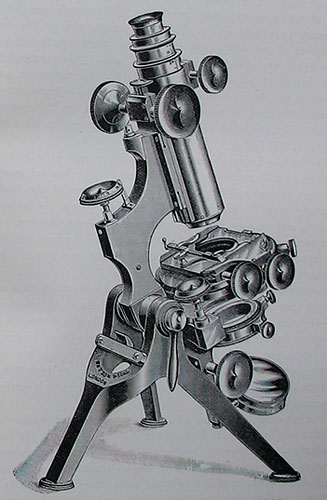
Fig 77. Watson's Improved "Van Heurck Bacteriological" Microscope. One of the many excellent drawings throughout the book.
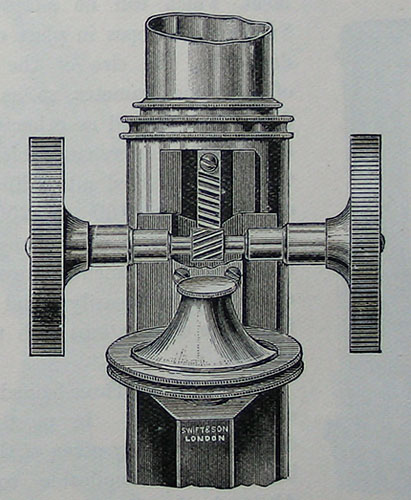
Fig 82. Swift's Spiral Rack and Pinion Coarse Adjustment.
The book is of a much more technical nature than those of Mr. Slack and Kerr but anybody interested in optics and the different designs by Zeiss, Leitz and all the British makers at the beginning of the twentieth century could do a lot worse than gaining a copy of Hogg. It is great having this book around when reading some of the other turn of the century books talking about their trips to the ponds and lakes bringing home the samples and inspecting them through their latest microscope, you can look through Hogg and actually appreciate the type of instrument they were using since it covers some very basic models all the way up to very complex designs by Zeiss, Swift, Baker et al. You can take your pick from the old bookstores since there is usually a good choice of editions going way back to the mid 1850's all the way through to around 1911, the later ones having considerably more pages. Highly recommended.
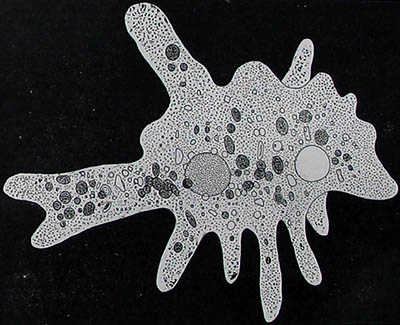
Fig 325. Amoeba, Proteus animalcule; magnified 600 diameters. - [Warne].
From Plate III. and Plate VI. The pages have a larger border than shown.
Click on images for a larger version.
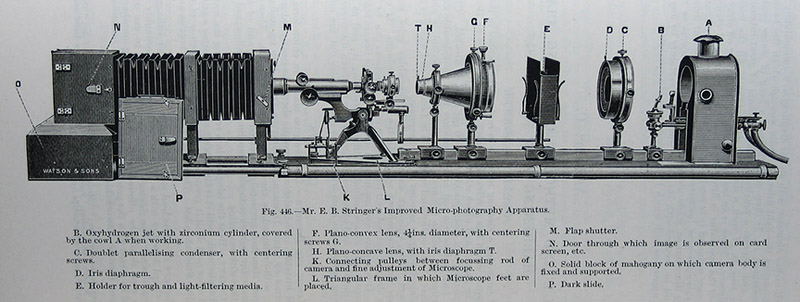
Fig 446. Mr. E. B. Stringer's Improved Micro-photography Apparatus.
I have seen samples of diatom photos taken with apparatus like the above and the resolution and detail surpasses anything I can get from modern Zeiss optics on my scope.
British Freshwater Algae. West and Fritsch.
My copy is cloth bound and rather tatty and was published by Cambridge University press in 1927, it runs to over 500 pages. Typical of the Cambridge press [past and present] this is a very technical book but the chapter on diatoms I have referred to with some nice line drawings of the construction of the frustule. My copy was referred to as a 'working copy' with many notes in ink scribbled inside and is in quite poor condition but it was very cheap, however it is not one of my favourite books. With a few exceptions I don't think the drawings are in the same class as Hogg.
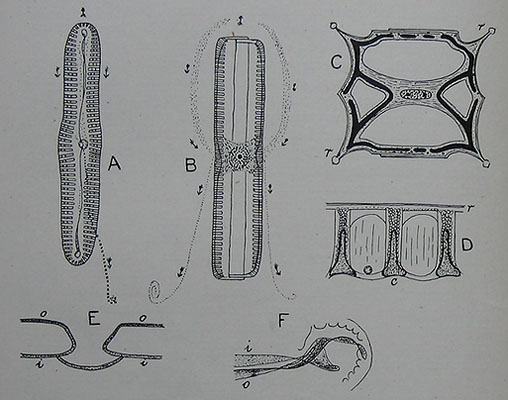
Fig 144 Showing details of diatom frustule.
Microscopic Freshwater Life. F. J. W. Plaskitt.
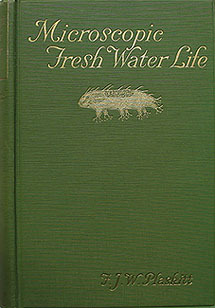
Microscopic Freshwater Life. F. J. W. Plaskitt. Green cloth bound, this copy was published in 1926.
This is a nice, fairly substantial book of 278 pages with good chapters on infusoria and rotifers, the writing style is very relaxed but informative with a minimum amount of technical jargon. The text is very well laid out with a paragraph and picture of the microscopic subject associated together. Although the line drawings are not as good as say Hogg they are more than adequate in portraying the beauty of the subjects discussed.
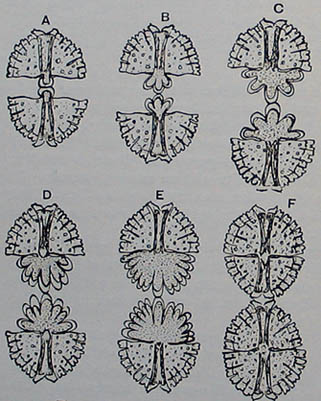
A close-up of Fig 119. Micrasterias Rotata in self-division.
From Chapter IX. Rotifers.
Their whole habit seems quite human in a way; they busy themselves to obtain proper food to eat and oxygen to imbibe, to find suitable accommodation and surroundings in which to dwell, arrange for the careful growth and production of their offspring and install around themselves a coat of Armour, studded with knobs and bosses, spines and points, to protect them from enemies and the unknown forces of nature, and to adapt themselves to withstand adversities and be amongst those fittest to survive. They have found and proved their place "in the sun" and have excelled us humans in that they have been dried and resusicated again in water, and as the story book says, lived "happily ever after."
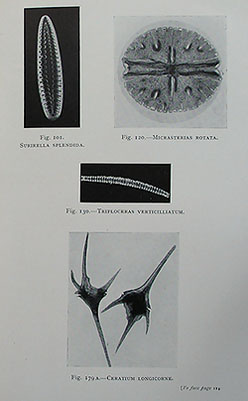
One of several B & W photo pages throughout the book.
Ponds and Ditches. M. C. Cooke. MA. LL.D.
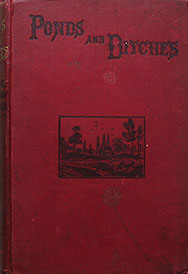
Ponds and ditches. 1906.
This is a compact cloth covered book being a modest 6 3/4" high by 4 1/2" wide and has 254 pages. It is nice to see a book like this covering flowering and non-flowering plants and algae together with good chapters on desmids, diatoms, protozoa and rotifers. Very concise text together with an easy going writing style with minimum technical terminology makes a pleasant few evening's read. There is a good selection of line drawings, a few of which cover most of a page, the quality varies a bit due to some of them being sourced from other publications.
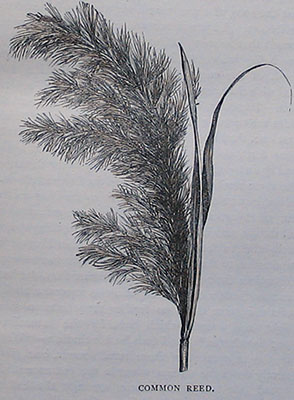
A typical line drawing from the book.
From Chapter VIII. Hydras.
If the body is halved in any direction, each half in a short time grows up a perfect hydra; if it is cut into four or eight, or even minced into forty pieces, each continues alive, and develops a new animal, which is itself capable of being multiplied in the same extraordinary manner. If the section is made lengthwise, so as to divide the body into two or more slips, connected merely by the tail, they are speedily resoldered, like some heroes of a fairy tail, into one perfect whole; or if the pieces are kept asunder each will become a polyp; and thus we may have two or several polypes with only one tail between them; but if the sections be made in a contrary direction - from the tail towards the tentacles - you produce a monster with two or more bodies and one head.
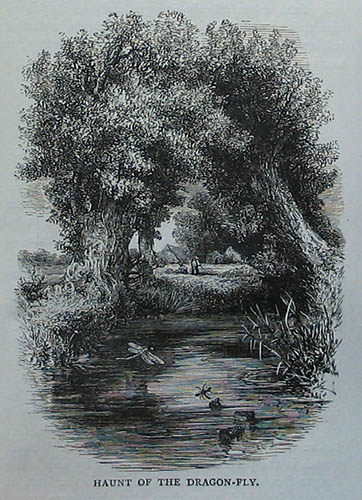
A nice print from the aquatic larvae chapter.
Evenings at the Microscope. Gosse.

Evenings at the Microscope.
This is one of Philip Henry Gosse F.R.S. best known works, I am unclear of the edition of this volume since there is no date stamp as such but the work itself dates back to 1859. The book is a modest 8" high by 5 1/4" wide and has over 500 pages covering many subjects outside of aquatic life including hairs, feathers, blood, insects and spiders etc but also includes some of his favourite subjects like rotifera and infusoria. If I had a small criticism it is that Mr. Gosse can be occasionally a bit verbose in his texts requiring sometimes two paragraphs to explain something rather than one! but on the whole a very enjoyable book with some nice illustrations the majority of which are from his own observations direct from the microscope, only 18 of the 113 are sourced from Dr. Carpenter's "The Microscope".
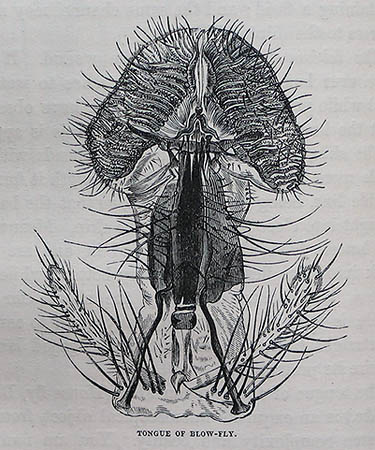
Tongue of blow-fly.
From his discussion on the blow-fly mouth parts.
The construction of these tubes is highly interesting: they are formed, like the air-pipes [tracheae], of a multitude of horny rings; but with this peculiarity, that the rings do not form a continuous spiral, but are separate and distinct; and are moreover imperfect; for each wire [so to speak] does not perform a complete circle, but only about two-thirds of a circle, leaving a blank space; and the tips of the wires end alternately in a fine acute point, and in a rounded fork, like the prongs of a pitch-fork. It has been said that these tubes are modified tracheae; but this fact is by no means obvious to me; for so far from their being connected with the general tracheal system, each of the four main tubes originates in an open centre, and each with an open extremity.
Rotifera. Hudson and Gosse.
![]()
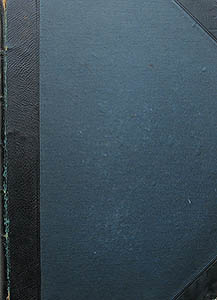
Volume I. The substantial main text of Rotifera.
General.
A combined effort between Charles Thomas Hudson [1828-1903] and Philip Henry Gosse [1810-1888] originally a 2 volume work a supplement was published in 1889 to update the British and foreign species found since the original publication. This is a recent purchase from the United States. I thought long and hard about purchasing Rotifera but I felt it my 'duty' to rescue a copy from sitting in a bookstore unseen from most amateur microscopists for what might have been a very long time. I consider myself just a temporary custodian of such a work, to admire it, use it, and make sure it is passed on to those who will find most pleasure in its covers. This was an important milestone and indeed a monumental work in its time in the study of rotifers during the latter part of the 19th century [1886-1889]. Published by Longmans, Green & Co. of London 1886 in 2 volumes, volume I contained the main body of text and volume II the associated plates arranged mostly as double page spreads and later in 1889 volume III the supplement. Unfortunately Mr. Gosse never saw the finish of the work, he died in 1888 aged 78. These are fairly substantial books measuring about 11" high by 8" wide and are very heavy for their size, the plates are made with thick card and are re-inforced with an extra cotton binding to the spine. It would be impossible to do justice to the content of these books here but it may form a future article if I can find out about copyright from the publishers and if the descendents of Mr. Hudson / Gosse will allow images to be shown, which of course may be almost impossible to find out.
Volume I.
Volume I has 144 pages and has a nice introductory section covering history on the study of rotifers and the likely locations to find certain types. It then goes on to describe individual species which in the typical language of the time is both authoritative but at the same time a pleasure to read.
Volume II.
There are 4 sepia tint and grey pen descriptive plates labeled A-D providing general information on body structure etc followed by 30 coloured or partially coloured plates each plate containing several or more drawings, all are to a very good standard with my own preference to Hudson's drawings which I think are superior in detail. The outlining and detailing of the colour plates are mostly in a sepia coloured ink rather than the usual black and the colour of card is a very light cream giving an overall luxurious look, much effort has gone into the preparation of these plates not only to look extremely attractive but providing the reader with a wealth of detail to compare his or her samples with.
Volume III.
Volume III is the supplement published in 1889, it has 4 more plates done in grey pen, it has 64 pages of main text.
Mr. Beebe.
My three volumes have a 'William Beebe' bookplate inside, I don't know whether this is an authentic stamp indicating that Mr. Beebe, naturalist, explorer, writer and of bathysphere fame [together with Otis Barton plunging the depths of the ocean to a depth of around 3000 feet in 1934] owned them at some time. I will need to do some checking but a cross reference with another bookseller suggests it may definitely be his bookplate and it is certainly possible he did own them since the dates would be correct. There is also a signature of a Mr. F. W. Headly dated 1901 so who owned them first I don't know. Any reader who can provide any further information on the authenticity of the bookplate or Mr. Headly would be welcomed. There are a number of sites on the Internet discussing William Beebe, his books and explorations simply by entering 'William Beebe' into your favourite search engine.
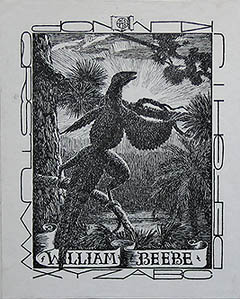
William Beebe bookplates applied on the inside cover of all three volumes.
Micrographic Dictionary. Griffith & Henfrey.
I have had to do some remedial work to the spine of my copy to prevent further deterioration but the fact it was referred to by Mr. Slack in his book several times and I'd heard that the plates were good I decided to buy a copy. Some of these are now going for very high prices at the old book stores, mine is the combined version with volumes I & II in the same binding, the text normally being in the first volume and plates in the second in other editions. Unfortunately I think it was a mistake to combine the two since it puts a lot of weight onto the spine especially if not properly supported. This, although not a particularly large book [8 3/4" high by 6 1/2" wide] is a weighty tome and very thick running to 845 pages in the text section alone! I nearly disappeared in a huge cloud of dust when I started work on it brushing it down ready for some renovation, obviously the poor thing had been neglected for some time. There is a stamp in the front saying it was owned by the Torquay Natural History Society. Depending on the edition the number of plates varies quite a lot with later editions have quite a few more compared to the earliest ones. The plates seem to be sourced from a small collection of artists.
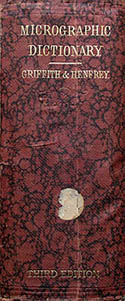
Micrographic Dictionary. In original binding, 3rd Edition. 1875.
There are 812 woodcuts like Fig 207 below plus 48 plates in my 3rd Edition of which some are in black and white, some in single colours like the desmid plate and others are in full colour. These are all at the back of the book effectively as a separate volume within the main work. I think the colour plates are absolutely first class, very sharp and detailed, indeed some of the best I've seen - my camera is not really doing justice to them but a flatbed scanner would need the pages flat which would cause too much damage to the spine. Considering it is now almost exactly 130 years old the vibrancy of the colours are truly excellent, some of the pages have never been opened since the final page cutting process has failed in a number of places requiring me to cut them apart which thankfully was very easy! The book is literally laid out like an A-Z dictionary of microscopic life and natural history including parts of the body. The time and effort in producing such a voluminous work over a 100 years ago must be applauded. There are some useful little keys for various subjects in the main text and each plate has a full list of the specimens accompanying it on the opposite page. It is nice to just pick a subject and admire the beautiful drawings and plates. Common microscopical subjects like infusoria, diatoms and rotataria get a fairly lengthy description.
First, a couple of woodcuts from the main text.
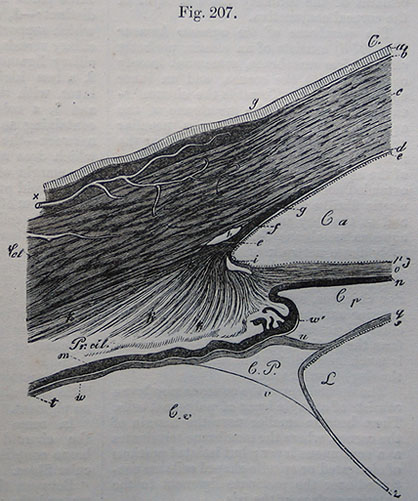
Fig 207. Section of the membranes of the eye, near the ciliary processes.
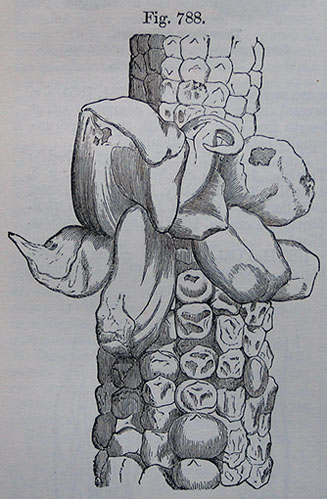
Fig 788. Portion of a spike of Maize infested with Ustilago maidis.
Now, four plates from the second part of the single volume.
Plates 34 and 35. Rotatoria. The pages have a larger border than shown.
Click on images for a larger version.
Plates 23 and 24. Infusoria, the colours here are a good facsimile of the originals.
And a close-up from one of the last few plates.
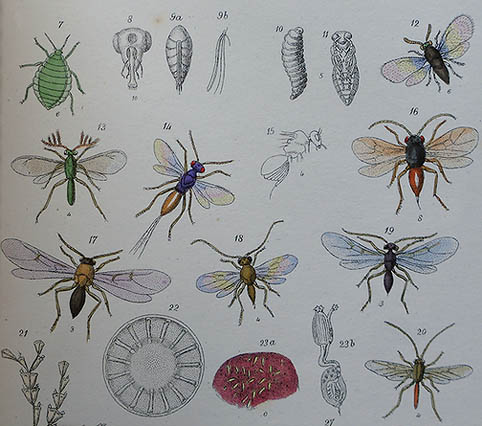
Plate 44. Various Insects.
Conclusions.
We can still learn a great deal from these old books especially with regard to making microscopy and related subjects interesting and fun to read. Of course there are still a number of books available today that are worthy of our attention especially if we are trying to identify something to the nth degree but that is not my forte, however, it doesn't stop my appreciation of some the very good artwork contained within. Alas, some of the classics like John Clegg's Observer's Book of Pondlife [I wonder how many microscopists in the UK started with this little book?] are only available second hand and the superb Collins field guide - Freshwater Life cannot be obtained at all, some U.S.A. sellers wanted upwards of £290 recently for this book which originally cost around £13. My brother has recently contacted Collins to enquire if there was a possibility of reprinting it.
I cannot think of any microscopy book written today with the same easy going but educational style of the Victorian [Queen Victoria, reign 1837-1901] and Edwardian [King Edward VII, reign 1901-1910] writers which is a shame, but all is not lost with contributions coming into Micscape and related sites from amateur and professional artists, photographers and writers from all over the world creating an extensive on-line library of great diversity. The skills of old are being continued in a different medium in such works as the beautiful drawings from Christina Brodie, stunning photomicrography by Wim van Egmond, the master of crystal imaging Brian Johnston, Richard Howey's and Walter Dioni's intricate observations of aquatic life...to name just a few.
I hope I have given you a flavour of the writing and artistry of the old masters, these books shouldn't be sitting on neglected bookshelves be it in libraries or bookstores but studied in living rooms, cherished and cared for, to be passed onto the next generation.
We enter a new era, the future uncertain, but as long as we continue to appreciate, respect and be fascinated by the natural world around us our little orb in the vastness of time and space should continue to look after itself, long may it endure : ).
And finally.
The final couple of lines of the book: Rotifers by Josef Donner [translated from the original text in German to English in 1966 and no longer available] sums up our microscopic world.
I am impelled also to lay stress upon the artistic interest of minute forms of life, particularly the Rotataria, those jewels of Nature. How frequently do ornament designers turn to butterflies and birds for their inspiration, yet does not the world of little things, especially the wheel-bearers, display an equal richness of lovely forms? 'The feeling for Art is dead in those who despise nature' - or should this saying be changed in these days of abstraction.
![]()
Comments to the author, Ian Walker, are welcomed.
Please report any Web problems or offer general comments to the Micscape Editor.
Micscape is the on-line
monthly magazine of the Microscopy UK web
site at
Microscopy-UK
© Onview.net Ltd, Microscopy-UK, and all contributors 1995 onwards. All rights reserved. Main site is at www.microscopy-uk.org.uk with full mirror at www.microscopy-uk.net .